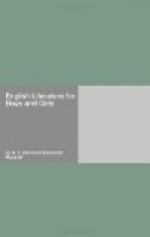Spenser has been called the poet’s poet,* he might also be called the painter’s poet, for on every page almost we find a word-picture, rich in color, rich in detail. Each person as he comes upon the scene is described for us so that we may see him with our mind’s eye. The whole poem blazes with color, it glows and gleams with the glamor of fairyland. Spenser more than any other poet has the old Celtic love of beauty, yet so far as we know there was in him no drop of Celtic blood. He loved neither the Irishman nor Ireland. To him his life there was an exile, yet perhaps even in spite of himself he breathed in the land of fairies and of “little people” something of their magic: his fingers, unwittingly perhaps, touched the golden and ivory gate so that he entered in and saw.
Charles Lamb.
That it is a fairyland and no real world which Spenser opens to us is the great difference between Chaucer and him. Chaucer gives us real men and women who love and hate, who sin and sorrow. He is humorous, he is coarse, and he is real. Spenser has humor too, but we seldom see him smile. There are, we may be glad, few coarse lines in Spenser, but he is artificial. He took the tone of his time—the tone of pretense. It was the fashion to make-believe, yet, underneath all the make-believe, men were still men, not wholly good nor wholly bad. But underneath the brilliant trappings of Spenser’s knights and ladies, shepherds and shepherdesses, there seldom beats a human heart. He takes us to dreamland, and when we lay down the book we wake up to real life. Beauty first and last is what holds us in Spenser’s poems--beauty of description, beauty of thought, beauty of sound. As it has been said, “‘A thing of beauty is a joy forever,’ and that is the secret of the enduring life of the Faery Queen."*
Courthorpe, History of English Poetry.
Spenser invented for himself a new stanza of nine lines and made it famous, so that we call it after him, the Spenserian Stanza. It was like Chaucer’s stanza of seven lines, called the Rhyme Royal, with two lines more added.
Spenser admired Chaucer above all poets. He called him “The Well of English undefiled,"* and after many hundred years we still feel the truth of the description. He uses many of Chaucer’s words, which even then had grown old-fashioned and were little used. So much is this so that a glossary written by a friend of Spenser, in which old words were explained, was published with the Shepherd’s Calendar. But whether old or new, Spenser’s power of using words and of weaving them together was wonderful.
Faery Queen, book VI, canto ii.
He weaves his wonderful words in such wonderful fashion that they sound like what he describes. Is there anything more drowsy than his description of the abode of sleep:




